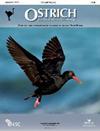Assessment of genetic and morphological differentiation among populations of the Diederik Cuckoo Chrysococcyx caprius
IF 1.1
4区 生物学
Q2 ORNITHOLOGY
引用次数: 0
Abstract
The Diederik Cuckoo Chrysococcyx caprius is an African species widely distributed south of the Sahara, which migrates seasonally between breeding and nonbreeding sites. It is currently unknown whether the species consists of a single panmictic population or if it is genetically structured. To investigate this, we analysed sequence variation in three mitochondrial and two nuclear gene regions in combination with morphological measurements in specimens from four localities. Phylogenetic relationships were estimated using maximum-likelihood methods and included samples of Klaas’s Cuckoo Chrysococcyx klaas, Red-chested Cuckoo Cuculus solitarius, and African Cuckoo Cuculus gularis. Haplotype networks and analysis of molecular variance were used to characterise the spatial distribution of genetic diversity. A principal component analysis was performed to investigate morphological variation among localities. Molecular analysis identified two divergent mitochondrial lineages, which were found to occur in sympatry in one South African locality (Limpopo Province). The magnitude of divergence between versus within these lineages was low (0.4–1%) yet significant (F ST: 0.84–0.88). Lack of apparent phylogeographic structure provides support for the absence of physical barriers to gene flow in this species. The divergent mitochondrial lineages did not differ in morphological measurements. The emergence and persistence of shallow mitochondrial divergence among sympatric lineages in the Diederik Cuckoo could be linked to maternal divergence in host selection of these brood parasites — a hypothesis requiring additional data to be tested.杜鹃(Diederik Cuckoo Chrysococcyx caprius)居群遗传和形态分化的评价
Diederik Cuckoo Chrysococcyx caprius是一种广泛分布在撒哈拉以南的非洲物种,它们在繁殖地和非繁殖地之间季节性迁徙。目前尚不清楚该物种是由单一的泛疫种群组成,还是有遗传结构。为了研究这一点,我们分析了三个线粒体和两个核基因区域的序列变异,并结合形态学测量了来自四个地方的标本。采用最大似然方法估计了克拉斯杜鹃(Chrysococcyx Klaas)、红胸杜鹃(Cuculus solitarius)和非洲杜鹃(Cuculus gularis)的系统发育关系。利用单倍型网络和分子变异分析来表征遗传多样性的空间分布。主成分分析研究了不同地区的形态差异。分子分析确定了两种不同的线粒体谱系,这两种谱系被发现发生在南非的一个地方(林波波省)。这些谱系之间和内部的差异程度很低(0.4-1%),但很显著(fst: 0.84-0.88)。缺乏明显的系统地理结构为该物种基因流动缺乏物理障碍提供了支持。不同的线粒体谱系在形态测量上没有差异。Diederik Cuckoo同域谱系中线粒体浅分化的出现和持续可能与母系在这些寄主选择上的差异有关——这一假设需要额外的数据来验证。
本文章由计算机程序翻译,如有差异,请以英文原文为准。
求助全文
约1分钟内获得全文
求助全文
来源期刊

Ostrich
生物-鸟类学
CiteScore
2.10
自引率
30.00%
发文量
24
审稿时长
>12 weeks
期刊介绍:
Ostrich: Journal of African Ornithology is the leading ornithological journal in Africa, and publishes peer-reviewed scientific papers and short communications (
 求助内容:
求助内容: 应助结果提醒方式:
应助结果提醒方式:


